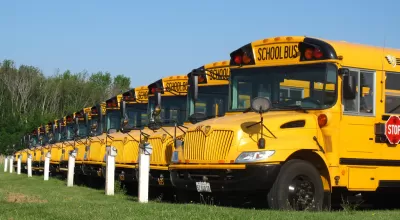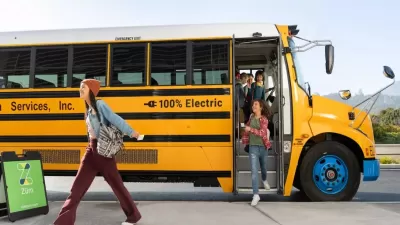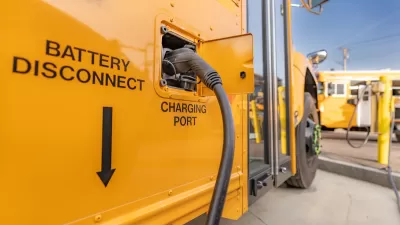The agency will distribute $5 billion over the next five years to help school districts purchase electric and low-emissions buses.

“On May 20, the Environmental Protection Agency (EPA) announced a $5 billion Clean School Bus Program, which will help school districts replace polluting diesel buses with clean electric ones.” According to a press release from U.S. PIRG, the program will distribute money over the next five years to cover the cost of new electric buses. “While buses that run on some ‘alternative fuels’ are eligible for some of the funding, the EPA is placing higher prioritization for applications for electric buses.”
As the release states, “The nation’s current fleet of 450,000 school buses primarily run on diesel fuel. As described in several PIRG reports, diesel exhaust has been linked to respiratory illness, cancer and other serious health risks.” Advocates such as PIRG are calling on school districts to shift to electric buses to protect the health of students and the community.
A March 2022 U.S. PIRG report on electric school buses outlines the potential for bus electrification to significantly reduce emissions in the transportation sector, the largest emitter of greenhouse gases. Electric buses can also serve as a source of backup energy. “The unique characteristics of school buses make them ideally suited to serve as a source of energy storage and emergency power. Their use patterns allow them to be available as a source of large volumes of energy storage, especially at the times when the grid is most vulnerable.”
FULL STORY: EPA opens applications, announces guidelines for $5 billion Clean School Bus Program

Planetizen Federal Action Tracker
A weekly monitor of how Trump’s orders and actions are impacting planners and planning in America.

Congressman Proposes Bill to Rename DC Metro “Trump Train”
The Make Autorail Great Again Act would withhold federal funding to the system until the Washington Metropolitan Area Transit Authority (WMATA), rebrands as the Washington Metropolitan Authority for Greater Access (WMAGA).

The Simple Legislative Tool Transforming Vacant Downtowns
In California, Michigan and Georgia, an easy win is bringing dollars — and delight — back to city centers.

The States Losing Rural Delivery Rooms at an Alarming Pace
In some states, as few as 9% of rural hospitals still deliver babies. As a result, rising pre-term births, no adequate pre-term care and "harrowing" close calls are a growing reality.

The Small South Asian Republic Going all in on EVs
Thanks to one simple policy change less than five years ago, 65% of new cars in this Himalayan country are now electric.

DC Backpedals on Bike Lane Protection, Swaps Barriers for Paint
Citing aesthetic concerns, the city is removing the concrete barriers and flexposts that once separated Arizona Avenue cyclists from motor vehicles.
Urban Design for Planners 1: Software Tools
This six-course series explores essential urban design concepts using open source software and equips planners with the tools they need to participate fully in the urban design process.
Planning for Universal Design
Learn the tools for implementing Universal Design in planning regulations.
Smith Gee Studio
City of Charlotte
City of Camden Redevelopment Agency
City of Astoria
Transportation Research & Education Center (TREC) at Portland State University
US High Speed Rail Association
City of Camden Redevelopment Agency
Municipality of Princeton (NJ)





























